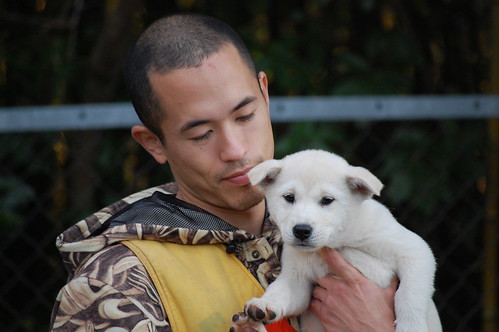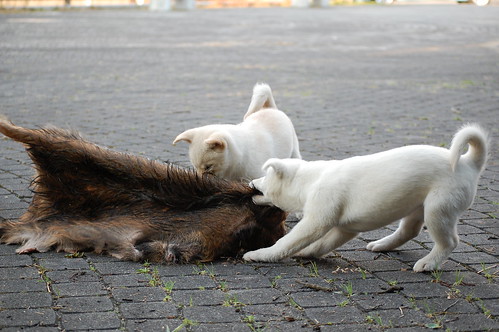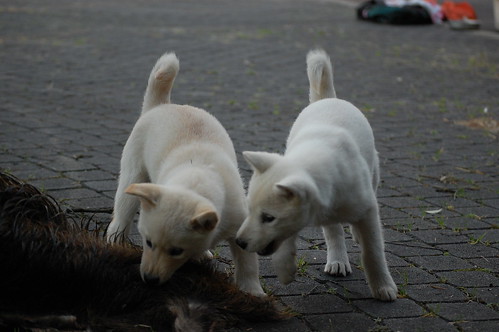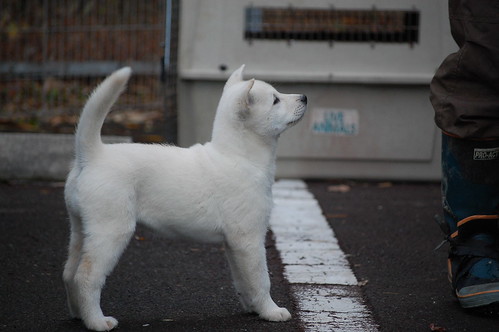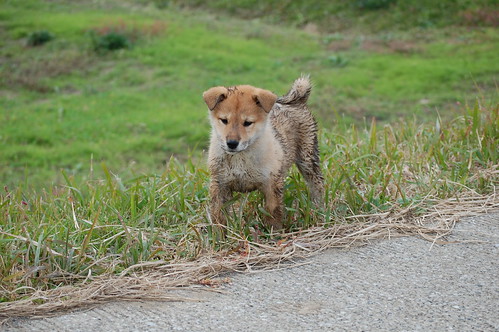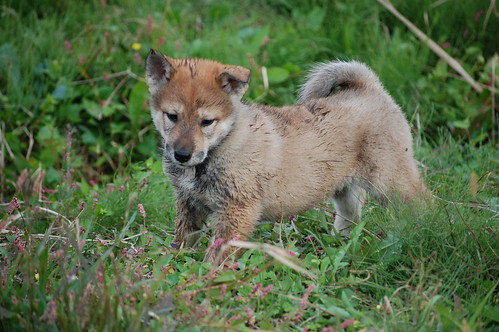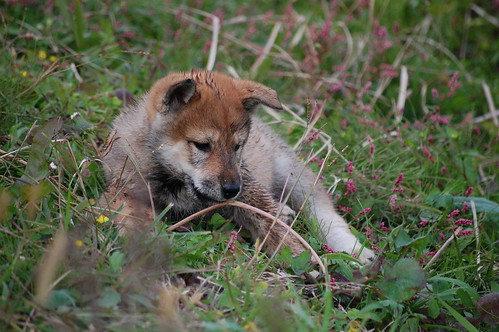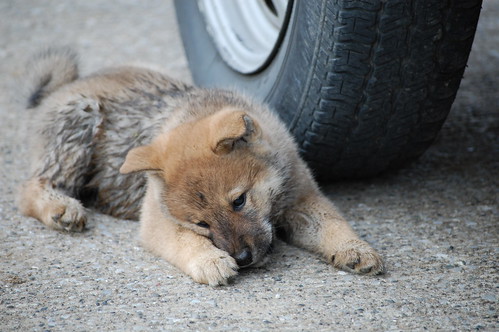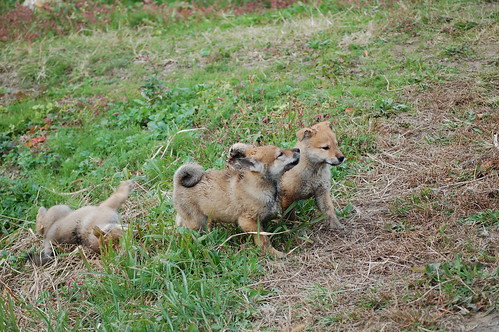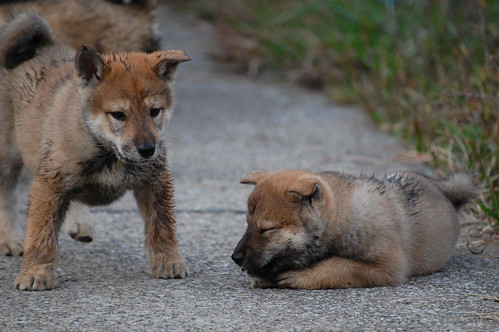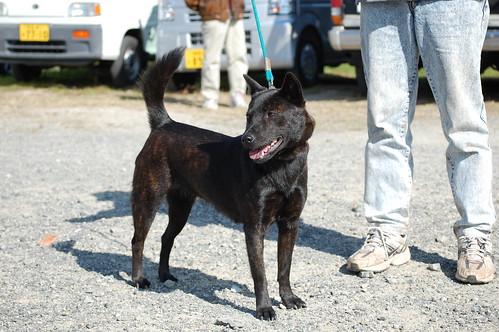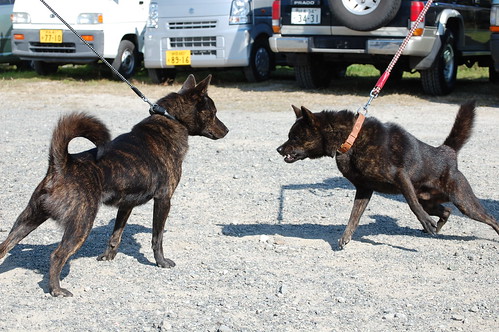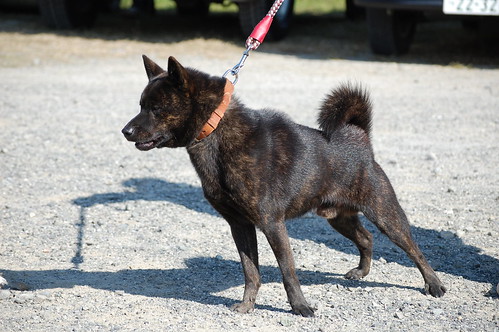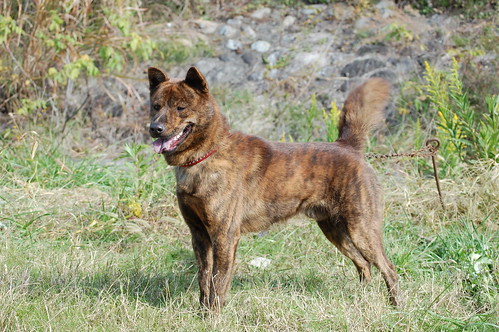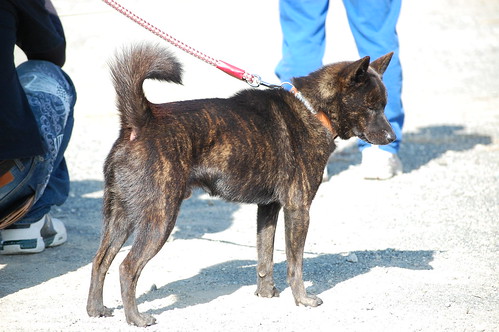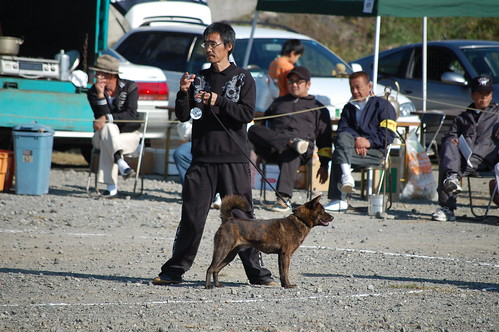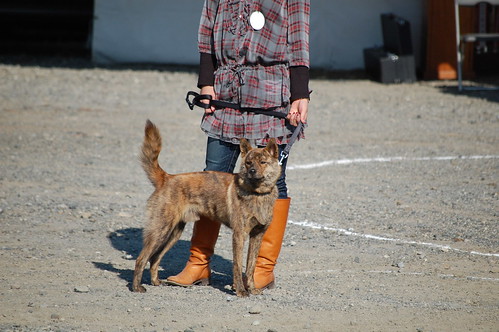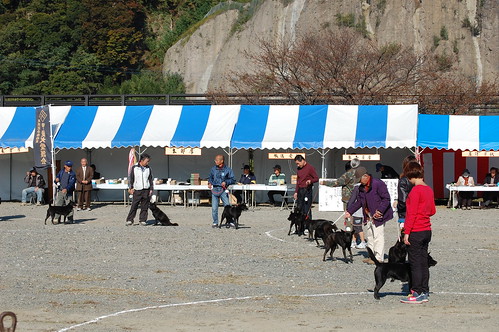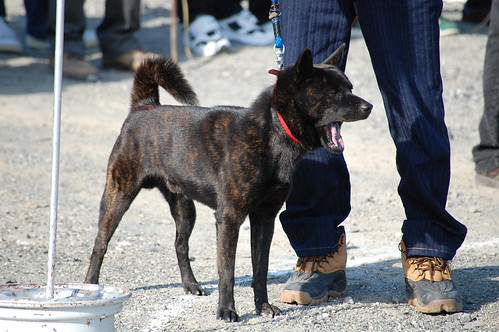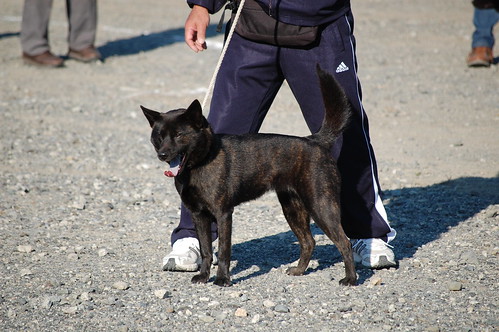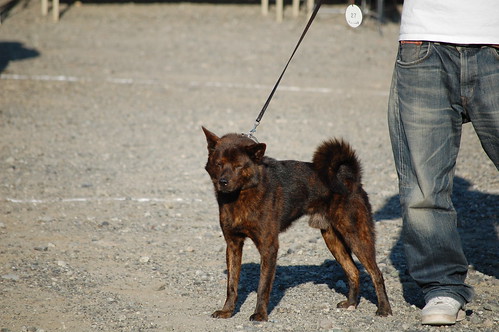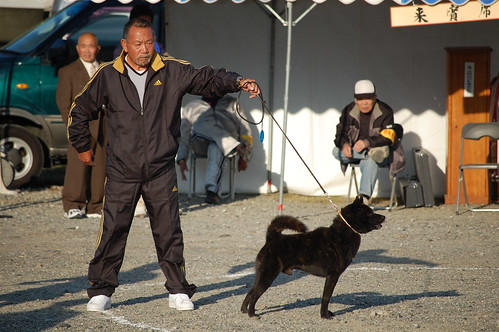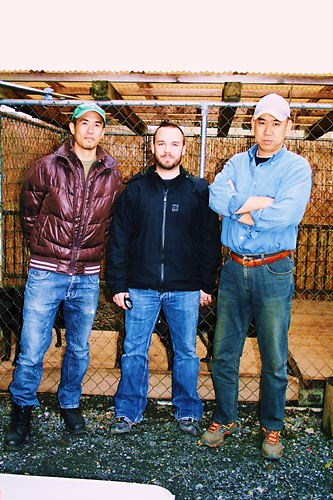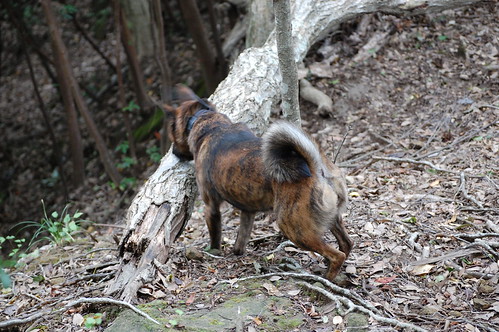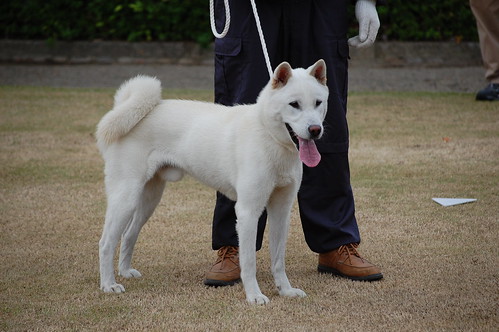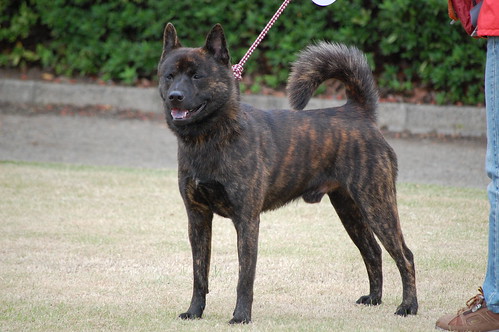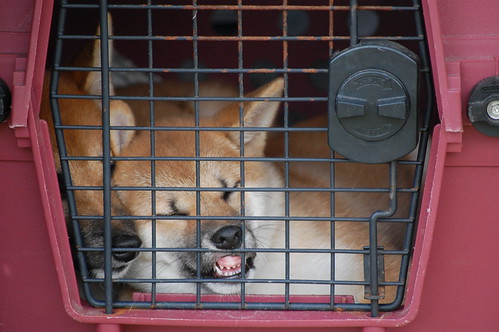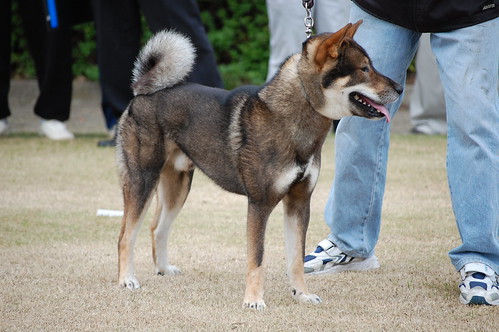I wrote a post on this a while back, but since I still get many questions regarding the breed, I'm editing and reposting this information.
The Kai Ken, also known as the Tora Inu (Tiger Dog), is one of the six, native, Japanese spitz type dogs. The breed's brindle coat distinguishes it from the other medium sized Nihon Ken. In size, the Kai is larger than the Shiba, but marginally smaller than the Shikoku, Kishu and Hokkaido, giving it a unique place among the Japanese breeds.
The ancestors of the Kai are thought to have been dogs brought over thousands of years ago by the Jomon, and later the Yayoi people. Due to Japan's geographic and political isolation, there was not much inter breeding with dogs from the continent. Of the Japanese breeds Kai, Hokkaido, and Ryukyu carry more of the genetic make up of the original dogs brought over by the Jomon, while the other breeds seem to carry more of the genes from the later dogs brought by the Yayoi. This can be almost completely contributed to geographics.
The Kai originated in the mountainous region of Kai (modern day Yamanashi) which gave the breed its name. Historical records tell of the famed brindle hunting dogs of the region, and their hunting prowess was believed to be second to none. While traditionally used to hunt Kamoshika, a type of mountain antelope similar to a chamois, their versatility and athleticism allowed them to be used to hunt many types of game, ranging from pheasant to bear. Today they are primarily used to hunt pheasant, wild boar, and deer.
As Japan opened up to the outside world, traders brought dogs with them. In many cases these dogs were systematically bred with the native dogs, as in the case of the Akita and the Tosa. The interbreeding was so widespread that in the early 1900s a movement began to save the remaining 'pure' native dogs. The mood in the country at the time was leaning toward ultra-nationalism, and the government actively encouraged the preservation of all things Japanese. Teams scoured the country to find the 'best' 'pure' dogs. Thus began the classification of the Japanese Dog (and the breed standards).
Kai numbers increased under national and prefectural government protection, with the prefectural government awarding tax breaks to owners of these national treasures. In the period during and following World War 2 most Japanese dogs faced harsh conditions and extremely depleted numbers due to food shortages, and in some cases laws banning the ownership of dogs. Many dogs were killed, their coats used to provide clothing for the military, and some were eaten. Thanks to its status and ardent supporters however, the Kai was left primarily intact, with many of the dogs being kept at local government offices and police departments. The fact that post war over half of the registered dogs in Yamanashi prefecture were Kai Ken shows just how effective these measures were.
The Kai is often cited as being the most 'pure' of the Japanese breeds (this is entirely anecdotal). This is mostly due to Yamanashi being extremely back country and mountainous, making it difficult for outsiders to enter the area. The Kai Ken Aigokai (Kai Ken Protection Society or Kai Ken Preservation Society) was established in 1931, and the first Tenrankai (exhibition) was held in April the following year. In November of the same year the first Nihon Ken Hozonkai (Japanese Dog Preservation Society) Tenrankai was held in Ginza, Tokyo. Of 81 dogs shown, 17 were Kai. The breed was given Natural Monument status in 1933. The rift between the Kai Ken Aigokai and Nihon Ken Hozonkai began when Nippo (Nihon Ken Hozonkai) classified all the Japanese breeds into 3 sizes, small, medium and large. The Kai was grouped in the medium category along with the Shikoku, Kishu, and Hokkaido.
The disagreement between the KKA and Nippo was mainly over size. The Kai did not conform to the measurements of the medium standard as set by Nippo. Slightly larger than the 'small' Shiba, they do not conform to the 'small' or 'medium' standard, ending up somewhere in between. The KKA standard calls for a height of 40-50 centimeters, with the Nippo 'medium' standard set at 51cm for males (give or take 3cm), and 49cm for females (give or take 3cm). The KKA was set on preserving the Kai as it was, without breeding to manipulate size to conform to the Nippo 'medium' standard. There was also a disagreement regarding the black tongue markings that almost all Kai have. According to the Nippo standard black markings on a dog's tongue is a flaw, and in the ring counts for a point deduction. A few years ago Nippo finally changed this rule, and the Kai is no longer docked points for tongue markings (though the amount allowed is still vague).
Due to these disagreements (and possibly other politics) KKA members stopped showing their dogs at Nippo events, and does not allow their Kai to register with other canine registration organizations. Any KKA Kai registered with another organization loses its KKA registration. Due to this, there are very few Kai registered with Nippo, and it is very difficult for them to do well in Nippo events due to size constraints (and until recently, tongue markings). There is a small group of Kai registered with Nippo, but the smaller gene pool and their larger than average size leave something to be desired. I have heard on occasion of Kai that do not do well showing at the Aigokai events due to size or other issues, switching to Nippo registration to compete in their events (less competition).
One stickler born of all this is that the Japan Kennel Club (JKC) which is the FCI recognized national canine registry, only allows registration of Nippo Kai, and not KKA Kai. So, anyone looking to export and register their Kai with an overseas canine registry can have problems getting KKA papers recognized. It is easier to export a Nippo Kai and get JKC papers, but due to the aforementioned reasons is not necessarily in the breed's best interest.
It is possible to register a KKA Kai with Nippo, but the dog will only receive a limited pedigree. Resulting litters from a limited registration breeding will also receive a limited pedigree. Third generation pups will receive a full Nippo pedigree which can then be switched to JKC registration.
There are roughly 600-800 Kai registered with the KKA every year, 100-150 with Nippo, and 100-200 with the JKC.
The FCI Kai standard describes the breed as: “A medium-sized dog, well balanced, sturdily built, muscles well developed. The dog has the characteristics of a dog living in mountainous districts of Japan. Limbs strong and hocks remarkably developed.” The are three recognized breed colors, all brindle: aka-tora (red), chu-tora (medium), and kuro-tora (black), with aka-tora being the rarest of the three variations. There is a recessive gene in the breed which occasionally produces non-standard white (or cream) colored Kai. Most Kai have dark spots on their tongues.Like all the Nihon Ken, the Kai has a double coat made up of protective coarse outer guard hairs, and a fine thick undercoat that is shed seasonally.
The JKC, Nippo, and KKA offer differing standards for the breed, with the Kai Ken Aigokai having the largest variation in size and type. The KKA standard recognizes Kai between 40-50cm.
The Kai as a breed is intelligent, athletic, and alert, with a strong desire to hunt. Like most Nihon Ken the Kai is an independent thinker. Many are very attached to their owners, and they can make excellent companions for the individual prepared to give them the attention and exercize they require. They can be territorial, and make reasonable watch dogs, but are not by nature guard dogs or protection dogs. They have shown the ability to be quick learners, with some active in Japan as search and rescue dogs. They are a rare breed even in their native country with an estimated population of around 12,000-14,000, and yearly registrations of between 800 and 1,200, (all registries combined). The main breed registry is run by the Kai Ken Aigokai.
